Corporate sponsorships had gone a great way towards paying for EPCOT Center when it opened in 1982, and with so many tens of millions of dollars apiece sunk into the new park the sponsor companies were keen to recoup their investment. It’s remarkable how extensively these corporations tied their identities into EPCOT; “their” attractions showed up in annual reports to investors, advertisements, and other publicity campaigns. Sponsorships were often a prestige line-item for corporate management teams, and perhaps after shelling out so much of their investors’ money to underwrite theme park attractions they felt it necessary to illustrate just what those dollars had purchased.
This was certainly the case when Horizons opened at EPCOT in 1983; sponsor General Electric was eager to show off its innovative new show, and they produced a booklet to tell the story behind its creation. The booklet was written by members of the General Electric P.R. staff – the same G.E. representatives that had been on hand during the pavilion’s creation. Every pavilion had its own corporate liaison; these were typically publicity staff from the sponsoring corporation who helped shape the attraction’s message and define each sponsor’s presence in EPCOT. For Horizons, this role fell primarily to G.E. staffer Ned Landon.
But first, a message from Leonard Vickers, G.E. Vice President of Corporate Marketing:
General Electric’s Horizons presentation is a celebration of man’s genius to stretch frontiers, to turn dreams into reality. At Horizons, you’ll travel to cities beneath the seas, to colonies among the stars. You’ll ride a hovercraft, see deserts bloom and mine the oceans’ floors. Optimistic? Sure. Unrealistic? No. One hundred years ago people thought Jules Verne’s dream that man would go to the moon was pie-in-the-sky. The message implicit in Horizons is: With the science and technologies already at hand, today’s dreams can become tomorrow’s reality. Any society that doesn’t try to stretch its horizons is destined to see them shrink. Like Verne, GE believes – “If we can dream it, we can do it.”
Thanks, Leonard.
Our next article from this booklet comes from Mr. Landon himself. Beware – it’s wacky!
HORIZONS AT EPCOT CENTER
BY NED LANDON
Ned Landon has spent most of his 30 years with General Electric at the Research and Development Center in Schenectady in jobs with titles like “manager-R&D Communications.” Since 1979 he has also been a Company representative on the WED creative team that designed the GE Horizons pavilion. Since Ned is a journalist/writer by background, and because he is knowledgeable about the Horizons story from its beginning, the editor offered him this unique chance to interview himself.
Landon: I appreciate your willingness to talk with me.
Ned: I do it all the time. Of course I can’t guarantee I’ll be able to answer all your questions. Also, I’m not sure I want to be interviewed for any publication that has a centerfold.
Landon: You’ll have to trust me. Let’s get right to the point. What is GE trying to do at EPCOT Center?Ned: Horizons is meant to entertain, inspire, and even try to educate – painlessly – some eight to nine million guests a year by providing them an exciting “ride into the future.” We hope that our guests will be extremely impressed by the Horizons experience. They will know that they are guests of General Electric, and we think the experience will strengthen their impressions of GE as a forward-looking, highly-technical, strong, solid, thoughtful, innovative company.
Landon: Does this mean they will see a lot of new GE products?
Ned: No. Horizons is not a showroom or trade show. That’s not the idea. In the first place, we’re showing a future far enough ahead – the next century, give or take a few years – that trying to reflect actual product designs would be foolish. What we do show are future environments – for living, working, playing – obviously made more pleasant and fulfilling through the kind of creative application of new technology that can be done by a company like General Electric.
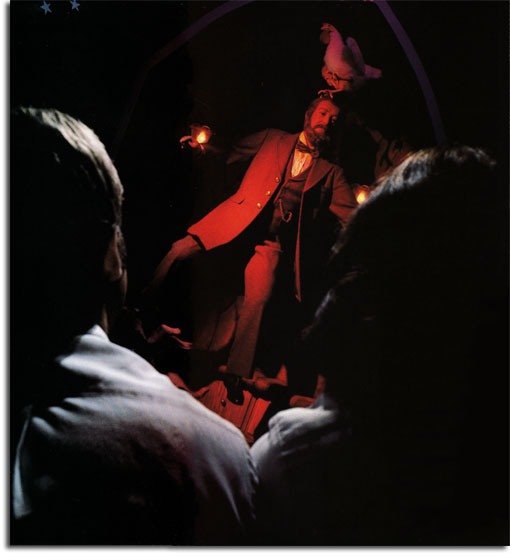
"'Horizons' "Looking Back at Tomorrow" segment illustrates predictions that famous futurists like Jules Verne (seen here on his way to the moon) had on transportation, space travel and robots."
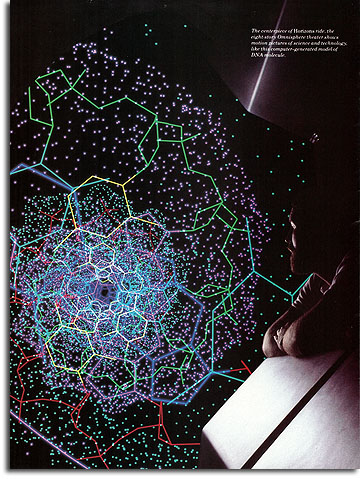
"The centerpice of Horizons ride, the eight-story Omnisphere theater shows motion pictures of science and technology, like this computer-generated model of DNA molecule."
Our guests will recognize that GE is a company always working diligently on new things and new ways to think about old things, that it is innovative and entrepreneurial, that it is made up of men and women who care about how technology is used. The Horizons “experience” is meant to make you feel good about the future and to feel good about a company called General Electric, which is trying to make these good things come true.
Landon: What sort of “new technology” are you talking about?
Ned: Obviously, in a 20-minute experience there isn’t enough time to explain a lot of new science in detail. But guests will come to better understand how research programs in microelectronics, information sciences, new materials, energy systems, meteorology, space exploration, transportation systems, medicine and biosciences – to mention only a few – form the basis of our hopes for the future. Then we’ll actually visit future living situations made more livable – and more fun – by things like holographic imaging, genetically-engineered farm crops, the mining of underseas resources and the use of outer space for medical, health, manufacturing and even recreational purposes.
Landon: That sounds neat. What’s the most wild-eyed projection in Horizons?
Ned: The possibility that people will go into space for recreation for the fun of it – for the excitement of doing things in zero- or low-gravity conditions. What a way for a little guy to slam-dunk a basketball! What a way to lose weight!
Landon: You really think that could happen?
Ned: Who knows? But what would my grandfather have thought if someone had told him that someday people would pay huge amounts of money to be flown in some machine with no visible means of support to go out to the Rocky Mountains in the middle of winter – all so they could slide down the mountain on plastic slats and then say they’ve never had so much fun in their lives?
Landon: Getting back to Horizons, how did it get its name?
Ned: Well, it’s a long story. At first the GE pavilion was to be called Century 3, or Century III. This was when people were still into the U.S. bicentennial. But EPCOT Center is not just for Americans. It’s for people from all over the world. The allusion to our own nation’s history seemed too parochial. Then somebody came up with Futureprobe. Not bad. But we always thought it had a rather uncomfortable medical connotation. We thought Horizons was just right. There always is a horizon out there. If you try hard enough, you can get to where it is – and when you do, you find there’s still another horizon to challenge you, and another beyond that.

"Urban apartment of the future features such amenities as holographic communications system (top) and hydroponically grown vegetables."
If Horizons had a subtitle, I’d vote for “An Achievable Future.” To me, that phrase means a lot about what we’re trying to do and say. We’re not predicting a better world based on wild guesswork or imaginary science fiction. Instead we’re saying that today’s technology – scientific understanding – is so advanced that it gives the human race magnificent options to shape a better tomorrow. To achieve a future with greater promise for everybody.
Landon: To bring good things to life.
Ned: I wish I’d said that. But let me go on for a moment. In Horizons we’re trying to say that the future is more than a dream – it’s an achievable dream if we’re willing to work hard enough to get there. And work together – people all over the world. And use all this great new technology to make things better. We’re also suggesting we can have this brighter tomorrow without sacrificing the best of our traditional values. For example, the Horizons experience is a family experience. The “stars” of our show are all members of a single family, living and working in highly diverse places but still keeping together.
We’re also trying to show that the future can be friendly, that it’s not something to fear. And we’re trying to at least suggest that the future won’t be all mapped out by someone else. We think there will be options, choices, even more opportunities than ever before to do one’s own thing.
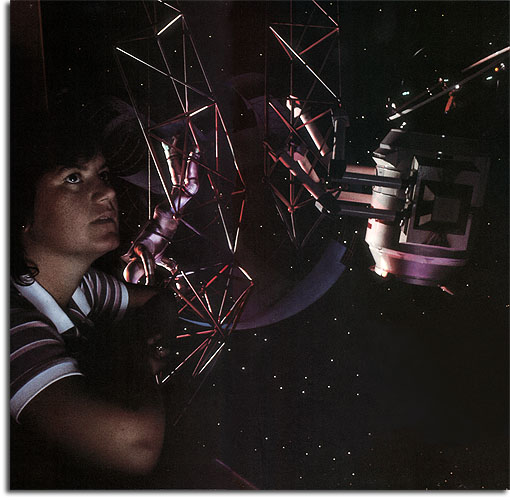
"Robots repair space satellite and mine manganese from ocean floor in scenes from Horizons' future habitats."
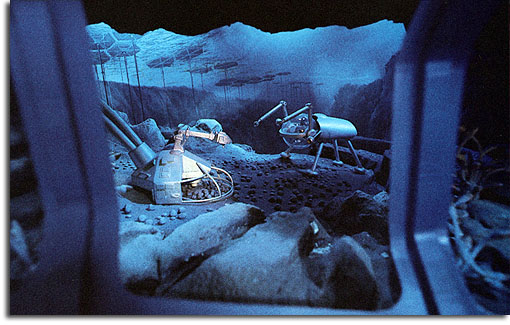
Landon: How do you get that point across?
Ned: Well, for one thing, we have what is probably the first ride show in history where the guests get to choose their own ending. As you complete your tour through tomorrow you get to decide whether you want to “ride back home” in a personal spaceship or in your own special submarine or in a slick little desert hovercraft.
Landon: How can you do this?
Ned: Disney magic, of course. And with some big help from General Electric’s Talaria® light-valve TV projectors.
You know, a couple of minutes ago you asked about GE products that will be seen in the show and I said that wasn’t the idea of Horizons. But behind the scenes, GE products are tremendously important. The ride vehicles are made of Lexan® polycarbonate. And they’re beautiful. The vehicles are powered by GE motors and drive systems, and there are GE controls all over the building. There’s GE lighting, too, inside and out. There’s a GE robot and GE’s Gemlink® video transmitter system and GE mobile radio applications and some beautiful amplifiers custom-made by Aerospace Electronics and some amazing new special uses for GE silicones and new infrared control systems, wiring devices, wire and cable, switchgear, transformers, the service shops and, well, I’ve undoubtedly left some out.
Landon: And you’ll undoubtedly get some phone calls about it if you did. You’ve talked about GE products behind the scenes. How about GE ideas in the show itself? How much did you have to do with what people see, hear and feel at Horizons?
Ned: The amount of personal credit I’ll try to claim will be in direct proportion to how much people tell me they like the show after they’ve seen it. But seriously, nothing should be said by anyone to take any of the credit for Horizons – and all of EPCOT Center – away from the magnificent team of creative people in the Disney organization. They have had full “creative control,” as they say in the business. They’ve been just terrific to work with. Extremely creative. A collection of artistic, architectural, design, writing, sculpting, movie-making, human-engineering, musical and heaven-knows-what other talent perhaps unequalled in the world.
GE established the fundamental theme for our pavilion: It must not dwell on the past, it must be dedicated to the future, forward-looking in its message. GE’s presentation must be about future technology because that’s what GE is all about. Everything about the presentation must reflect GE’s reputation for – and dedication to – quality. Finally, the future should be exciting and thus the GE presentation should be a ride – a thrilling ride – to and through an exciting tomorrow. The Disney people seized on these basic guidelines and developed the initial concepts.

"Horizons' space colony includes the latest in health and recreation equipment, including a body scanner to monitor vital signs during exercise."
We had ample opportunity to ask questions, to suggest changes, to add our own ideas. Some of our people who had worked closely with the Disney organization since the planning for the GE Carousel of Progress at the 1964 New York World’s Fair were instrumental in getting GE’s EPCOT Center project off and running. Incidentally, after nearly 20 years, the Carousel is still delighting audiences at Walt Disney World. It was Dave Burke who promoted the idea of using Imax-type movie projection, which led to the exciting “Omnisphere” in Horizons. And a lot of other people from around the Company got involved, too – from Nela Park for lighting, from Louisville for what a future kitchen might look like, from Medical Systems for how diagnostic equipment might be used in space, and from our aerospace experts. And – once again – I know I’m leaving out a lot of people."NASA and Cal Tech's Jet Propulsion Lab provided input for "growing" large, ultra-pure crystals for semiconductors in space colony set."
An advisory group at the R&D Center came up with a number of suggestions very early in the planning. For example, they made a big point of insisting that somehow our show should assure our guests that they will still have options – personal choices – for the kind of future life they’d prefer. I even got a couple of ideas in there myself – and a couple of thousand that got shot down.
But when it comes to knowing how to communicate with millions of people in ways that have been proven to be effective, there is no organization in the world that has come close to Disney, and we have depended on their final judgment about how our message should be presented at EPCOT Center. It’s been a remarkably cooperative, pleasant, tension-free and productive experience.
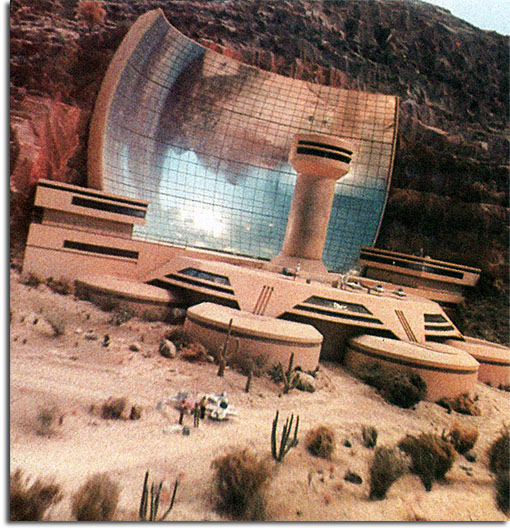
"The pavilion's finale will permit audiences to choose their own ending to the Horizons experience: a high-speed ride through a desert, undersea or space colony."
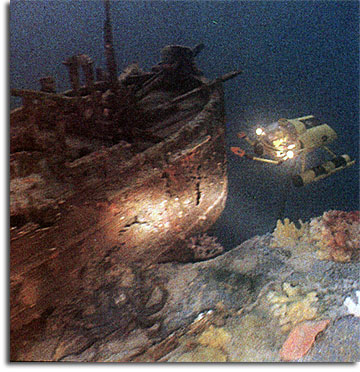

Landon: I’ve heard it said that Horizons is the pavilion that “ties EPCOT Center all together.” What does that mean?
Ned: The other major pavilions at Future World are mainly devoted to particular areas of technology: communications at AT&T’s Spaceship Earth; energy at the Exxon pavilion; transportation at GM’s World of Motion; agriculture at Kraft’s The Land pavilion; underseas technology and life-and-health science at two pavilions yet to be built. Kodak has a fine presentation on the theme of Journey Into Imagination. Our Horizons is a synthesis of all of those – an imaginative presentation of what the future can be like if we make the best use of all the different technologies represented in those other pavilions. We really do “pull it all together,” and a number of observers have commented that they think Horizons is the pavilion that most completely represents what Walt Disney himself many years ago envisioned for EPCOT Center when it was his “last and greatest dream.”
Landon: How do you think people will react to Horizons?
Ned: Millions and millions of people – that’s 2,500 every hour, 14 hours a day, 365 days a year are going to see Horizons, and I can’t help but believe that most of them will like it very much, will get a real lift from what they learn and will come away feeling good things about the sponsor. But anyone who doesn’t think there won’t also be critics just doesn’t understand this business. Sure, our view of the future is optimistic – some will say “sugarcoated.” Yes, we’re showing a future without slums or crime or arms races or drug problems or a lot of other terrible things. Yes, some will think we’re too far out while others will think we’re not Buck Rogers-ish enough. Some will ask why this or that new technology was ignored. In a presentation such as ours, for a very large audience, there is always debate over the proper proportion of”entertainment” vs. “education.” Walt Disney World itself is one of the most remarkable places in the world, but that surely doesn’t mean everyone in the world loves it. Not everybody. But any place that attracts 23 million people in a single year – that’s 23 million! – has to rate as one of the most phenomenal success stories in history.
Landon: Boy, do you sound enthusiastic.
Ned: I am an unashamed, unadulterated, on-the-record enthusiast for Walt Disney World – both the Magic Kingdom and EPCOT. I’ve never been anywhere – anyplace – where people seem to interact with each other so admirably. I believe Walt Disney World and Disneyland are great examples of private enterprise – superbly managed businesses, examples of good old American ingenuity, examples of big projects being done without government “help” – major reasons why people from other countries visit the U.S.A. and leave feeling glad they came, examples for all the world to see that a lot of things that often aren’t done very well in this world can be done right.
Landon: Well, Ned, what are you going to do for kicks now that the planning of Horizons is over?
Ned: I’ve often asked myself that same question. But, for now, let’s just say I’m going to be on the Horizons ride every chance I get.
Sounds like a plan to me.
We’ll be back soon with more of General Electric’s Horizons tale…
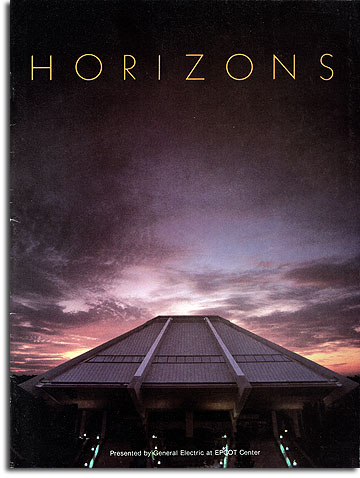
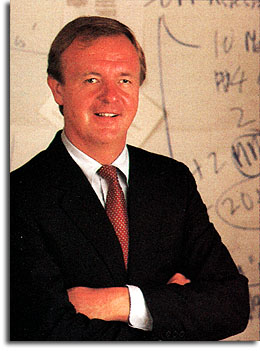
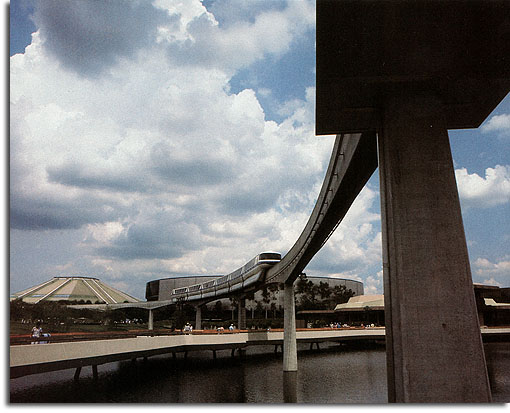


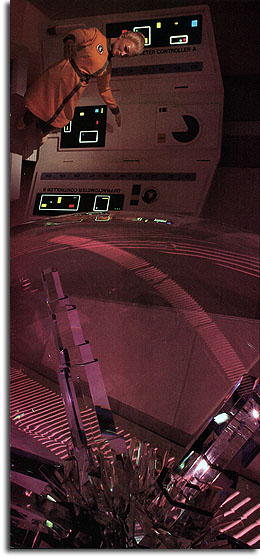









awesome. thanks for posting, I love that first image up there. Looks more intriguing and forward-thinking than anything they’ve put into epcot recently.
Horizons should have been in the ball.
Ever a hint, even the teeniest, of that being a thought back in the day? Please someone say there was some crazy story about 48 hours when the idea sprung forth, only to die a quick death as corporate heads prevailed. Let’s make up the story….
The interview was hilariously awesome. And yes, very wacky!
Awesome post! Made my day for sure. Horizons was my favorite ride at Epcot the first time I visited as a kid in 1984, and it still remains the best achievement in that park.
I can’t bring myself to read this…because then it’ll be over. I’ll just stare at it for a while and enjoy the anticipation.
“Any society that doesn’t try to stretch its horizons is destined to see them shrink”
That’s an important quote, and we’ve really seen the truth of it at EPCOT over the last decade-and-a-half or so.
I think the name hurt it’s prospects. Horizons sounds like a retirement community or a rehab program. Century 3 is forward looking, but may be confused with real estate and gold sportcoats. If it had been in the ball then everyone would have gone on it and it would still be there today. “Horball Earth”.
Loved the attraction. I’ll never forget my first visit to EPCOT.
[…] CommentsMark W on Checking In…beaglelady on The Horizons Story, Part IRO93461 on The Horizons Story, Part Ifutureprobe1982 on The Horizons Story, Part ISmaha on The […]
Why was Horizons shuttered? Or perhaps there’s an official reason and a real reason?
Thanks for the kind words, everyone! I’m glad you enjoyed it. There’s more to come.
@Eddie – I’ve heard it said many times that this is the show that should have been inside Spaceship Earth. If only GE had signed on earlier – the things that might have been! But yes, as the “thesis statement” attraction this would have fit much better there as an introduction to the park.
@Smaha – No worries, like I said – more is on the way! I know what you mean, though. I get things like this and don’t even read them for a while because I want to savor it.
@futureprobe – EXACTLY
@beaglelady – Horizons was closed because it no longer had a sponsor, and without a major refurbishment ridership had dropped off. Even a cosmetic overhaul – new costumes and decor in the future scenes, for instance – would have made a huge difference. During those last five years they let the ride increasingly “go to seed”, and things got pretty rickety. Effects like the finale film needed upgrading. Without a sponsor, Disney would have had to pay for it, and they weren’t going to. Instead of retrofitting a Space attraction into the existing building, they decided to tear it down and start over. Sad, sad.
Sad…did they save any part of it?
Horizons would have been better suited for the sphere simply because it encompassed so many different ideas. It didn’t fit into a easily defined theme such as “energy”, “imagination”, or “transportation” but included a little of each.
Even so, “communication” is still a good choice for Spaceship Earth since it’s a fundamental aspect of human ingenuity and all we have accomplished depends so heavily on how we communicate. Earth Station seems like it was a good post show since it introduced the rest of EPCOT Center. Sadly, that no longer is the case.
[…] Progress City USA – Three part review of the General Electric promotional booklet for Horizons… […]
I have written a four part story of my design experience as Project Show Designer for Horizons on mouseplanet.com.
http://www.mouseplanet.com/index.php
Click “Articles” and then “George McGinnis”
I hope you enjoy them, Horizons was my longest project at Walt Disney Imagineering in my over 30 year career.
George
PS GE was late in signing up for sponsorship, but ended up with the best people to create Horizons ride/show — those retained after the layoffs when Epcot opened.
GFM
[…] dispenser reminds me of a hydroponic situation which does exist in The Land and was showcased in Horizons. What might not exist today is in-ceiling […]
I miss Horizons terribly.I wish it was brought back.I liked slower not thrill rides.
It was relaxing and inspiring for me as a future artist.
The Space ride that’s in it’s place now just doesn’t have the magic and awe this ride had.
I can remember the orange smell and the futuristic city murals in the background.
It made my childhood great and left a impression me.Thrill rides just don’t do that and Epcot was special because it wasn’t like Disney World and yet it wasn’t like an amusement part ether.
But I fear with the charector rides it’s becoming a mishmash of Disney world and amusement ride thrown it and less about the future and the countries it features.
Over time I feel Epcot is losing it’s identity and Horizons closing along with Universe of Energy and World of motion were the signs it was.
God bless the wonderful imagineers that made this ride and my other favorites I mentioned that aren’t there anymore.
Horizons was the project my dad was working on when he passed away in 1986.
I was sad when they shut it down.